Americans are split over the Trump verdict. So are New York’s criminal law professors
Here’s what happens when you try surveying criminal-law professors about an unprecedented case in their state of New York: the guilty verdict of Donald Trump.
CBC News asked them two things: their view of the case and of Trump’s chances of winning an appeal.
We contacted two dozen professors specializing in criminal law and in particular white-collar crime, given that this case was about falsifying business records.
The vast majority declined to comment, for different reasons. One divulged that he trusted few colleagues to offer an unbiased opinion, untainted by their own politics.
Responses from Americans in New York City and from outside the White House were firmly divided. Supporters of former U.S. president Donald Trump insisted it was an unfair process and that they were still committed to voting for him in the next general election. Meanwhile, Trump’s detractors cheered and hugged in celebration, satisfied that he wouldn’t be treated as an individual above the law.
But five answered. Two expressed doubts about the case, two did not, and one shared detailed analysis without stating an emphatic opinion.
The scattershot responses demonstrate that the reaction to this trial goes well beyond the partisan sparring on cable TV news.
A former colleague of Manhattan District Attorney Alvin Bragg says it must have been difficult to decide whether to proceed with charges.
“I’m sure he had a lot of sleepless nights,” said David Dorfman of Pace University, a former criminal defence lawyer and Bragg colleague at New York Law School.
“Because what if Trump has gotten acquitted — or a hung jury? There’d be a lot of second-guessing.”
Would he have done it? Without stating his own view, Dorfman described it as a difficult call.
He says he’s not certain Bragg would have proceeded, had he not inherited the ongoing investigation when he entered his role in 2022, with his staff having already poured considerable effort into it.

At the same time he defends Bragg as a straight-shooter and defends the case against some criticisms.
Trump is accused of more serious crimes. However this case is likely the only trial he will face before the November vote, including for the attempted overturn the 2020 election.
What’s unique about the Trump case
Some basic facts of the case are clear-cut: A porn star said she’d had unprotected sex with Trump two decades ago, while his wife was pregnant. Then, during the 2016 presidential campaign, a Trump ally paid her $130,000 to keep quiet and, after the election, Trump repaid that ally, Michael Cohen, but declared it was for legal fees — a business expense.
Whether this constitutes a felony, however, is what’s being disputed.
There’s a fundamental fact about the crime charged here: Falsifying business records is only a felony if it’s done to hide another, underlying, crime.
As an example, let’s use a pizzeria business. The pizzeria owner can falsify records, scribbling down a made-up total for how much tomato paste he bought. If it was done out of carelessness, that’s not a felony. If it was done to cheat on taxes, it is.
The accusation was that Trump intended to hide up to three underlying crimes: violating the spending limit for a federal election, in the process breaking both a state crime against fraudulent campaigning and a state tax law.
Alex Panetta, a Washington correspondent for CBC News, was in the New York courtroom on Thursday when the jury read out the verdict convicting former U.S. president Donald Trump of 34 charges. Here’s what he saw.
Jurors were instructed that it didn’t matter which crime Trump intended to conceal, nor whether they all agreed on the underlying crime, nor whether he ever committed that underlying crime, nor whether he was charged.
All that mattered was whether they reached a unanimous verdict that he falsified records, and that he did so intending to break any of those three laws.
So was this process rare, and was it proper?
“The use of three crimes in this case was both rare and risky,” said John Coffee, a professor at Columbia University in New York City who specializes in business crime.
“It raises the prospect of a unanimous jury where four [jurors] think [Trump committed] Crime A, four think it is Crime B and four think it is Crime C, but not even a majority supports any specific crime.”
Asked whether Trump has a good chance at winning his appeal, Coffee says yes — for several reasons.
He cites the Enron case, when a lack of clarity about how jurors interpreted the case led the U.S. Supreme Court to narrow the charges.
He also raises the potential argument that, constitutionally, Trump is protected against being required to reveal the affair.
He also raised federal-state issues, like whether rolling the federal elections violation into the state charge will stand.
“On this basis, Trump has a shot at a successful appeal,” said Coffee, saying there’s a chance no law was broken here, and that it’s not obviously illegal to pay hush money.
Anthony Dillof at Wayne State University in Michigan predicts Trump would likely win at the U.S. Supreme Court if it agrees to hear his petition for review.
That appeal would be launched on constitutional grounds, usually after the appeals process in state courts, which could take a couple of years.
Anthony Capozzolo, former federal prosecutor and former assistant U.S. attorney for the Eastern District of New York, discusses Donald Trump’s multiple guilty verdicts and whether the former president’s criminal conviction could lead to jail time.
State prosecutors have said charges over falsifying business records are extremely common — the Manhattan DA’s bread and butter.
It’s true that this crime is commonly charged, Dillof said. What’s not common is using it to enforce a federal election law.
And he suggests politics drove the case.
“[That] is a certainly novel application of the law — one that I would describe as a ‘stretch,'” he wrote in an email.
“I do not believe such a stretch would have been made if the target were not a polarizing political figure like Donald Trump. Thus, I view prosecution as problematic.”
Dillof adds that he has colleagues he respects who disagree with his assessment.
And disagree they do.
Just because this case is novel, Dorfman says, doesn’t mean it’s inherently problematic. Unprecedented cases happen, he says.
“That doesn’t mean it’s illegal or unconstitutional,” he said. “Things happen that never happened before.'”
That said, Trump could try several avenues for appeals.
They include the federal-state issue, accusations of bias and the jurors being told they need not agree on an underlying crime, he says.
But Dorfman has no patience for the bias argument, dismissing as “absurd,” for example, the suggestion that Justice Juan Merchan disqualified himself by donating a few dollars to Joe Biden’s campaign and because his own daughter works for some Democrats.

“The judge played it very fairly, down the middle,” Dorfman said.
He also doubts Trump’s argument that jurors needed to agree on one underlying crime, but is less emphatic here: “I think that’s a closer call.”
He predicts Trump’s appeals will fail in New York state, then possibly succeed at the Supreme Court later, in well over a year, unless it takes the rare step of agreeing to hear the case immediately as an emergency.
At Cornell University, John Blume says it’s a common instruction to jurors that they need not agree on the exact underlying crime, as long as they’re unanimous that there was one.
“There is nothing unusual about the judge’s charge,” he said. “It is totally consistent with New York law.”
He says he doesn’t see an appellate reversal as likely, but without having read the full case record can’t say with certainty.
Rachel Tillie Goldberg, who practised appeals and founded the Appellate Criminal Defense Clinic at Cornell, says she never predicts the outcome of appeals.
But she praises Merchan as an experienced judge, expressing confidence he was scrupulously careful.
“His rulings seemed eminently reasonable,” she said.
“That said, no trial is without error. Often the question … is whether the error was so significant that it affected the verdict, which is a high bar to meet.”
She says there’s nothing unusual about prosecutors aggressively pursuing a case — even piling on charges to encourage a guilty plea.
That’s one reason few falsification of records cases ever make it to trial, she says.
Published at Sat, 08 Jun 2024 08:00:00 +0000
China’s EV market is going global. Can U.S., Canada balance protectionism with reducing emissions?
China’s electric vehicle industry is poised to dominate the globe, and that has governments in Europe and North America, including Canada, grappling with how to meet ambitious targets for reaching 100 per cent zero-emission vehicle sales through domestic manufacturing.
“In the last five years or so, China emerged as an absolute leader in [the EV] space,” said Alla Kolesnikova, head of data and analytics at Adamas Intelligence, a research and consulting firm specializing in strategic metals and minerals based in Toronto.
As a result, the U.S. has raised tariffs on EVs from China. The Canadian government is now exploring whether to follow suit.
Meanwhile, both countries have set aggressive goals for getting substantially more EVs on the road to reduce reliance on fossil fuels.
The federal government’s electric vehicle sales mandate regulations include a national target of 100 per cent zero-emission vehicle sales in Canada by 2035. The U.S. is aiming to have between 35 per cent and 56 per cent of all vehicle sales between 2030 and 2032 be EVs.
Federal Minister of Innovation, Science and Industry François-Philippe Champagne tells Power & Politics that Canada and the U.S. are ‘very aligned when it comes to protecting our key supply chain’ and jobs in North America. U.S. President Joe Biden announced earlier this week he would be hiking tariffs on Chinese imports, including electric vehicles.
The problem, according to many analysts, is that both countries have a long way to go before their EV industries becoming self-sustaining.
Many industry watchers say it will take a lot of political will — and money — for Canada to develop its own industry and spur adoption without relying on Chinese car makers.
Barriers to EVs in Canada
According to Statistics Canada, zero-emission vehicles accounted for just over 10 per cent of all new motor vehicle registrations in 2023, an increase of 49.4 per cent from 2022.
However, moving past these early adopters will be a challenge, according to Niel Hiscox, president of Clarify Group Inc., a Canadian-based automotive research and advisory firm.
Hiscox says the higher upfront costs will mean a “a good chunk” of consumers will decide not to buy it. “You can’t make the transition if the cars aren’t there, if they’re not affordable.”
Commenting on the “chicken and egg” situation of building more capacity in Canada, Flavio Volpe, president of the Automotive Parts Manufacturers’ Association told CBC’s Metro Morning, as they build up capacity, prices should come down. As prices come down, more people will buy EVs and as they do, more charging stations will be built.
“If you agree that we’re in a climate emergency, we need to do everything we can to encourage people to make a switch,” said Cara Clairman, CEO of Plug n Drive, a non-profit committed to accelerating electric vehicle adoption in Canada.
Clairman says provinces like B.C. and Quebec have a higher adoption rate because of charging infrastructure, government subsidies and policies to encourage EV adoption.
Low cost, high quality in China

China’s dominance can be attributed to a few factors, including the cheap cost of the vehicles and the fact there’s a wide variety to choose from, according to Kolesnikova.
“There is an electric vehicle for any segment and any prospective buyer,” she said. Those range from cheaper, smaller, more basic cars, to larger SUVs and luxury sedans.
In fact, the Seagull, a tiny electric car launched by Chinese automaker BYD (Build Your Dream) last year sells for as low as $10,000 US, or about $13,000 CAD, and it’s just as robust as American cars, according to industry experts.
“It’s low cost combined with high quality,” said Chengyi Lin, professor of strategy at INSEAD Business School in Fontainebleau, France.
That cost is, in part, a result of government subsidies and an integrated supply chain, according to some analysts, as well as stiff competition from more than 100 companies who want a piece of the market.
That, and the fact that China mines an abundance of the metals and minerals needed for EV batteries, including lithium and cobalt, means they have the supply chain locked down, said Kolesnikova, who points out China is a major exporters of EV batteries, too.

“There’s vertical integration for the companies there for sourcing battery metals and materials,” she said.
Lin also credits charging infrastructure for China’s quick adoption. According to the International Energy Agency, almost 60 per cent of all new electric car registrations were in China in 2023.
He said traditional office spaces or commercial spaces on the first floor of buildings are also being converted to charging stations, while taxi companies are re-vamping the drivers’ shifts to accommodate range limitations.
“It’s a whole ecosystem at play.”
EV expansion, possible tariffs
Not for lack of trying, Canada has been trying to speed things up.
In mid-May, Prime Minister Justin Trudeau and Ontario Premier Doug Ford were among politicians in Port Colborne, Ont., announcing a new $1.6-billion EV battery plant thanks to an investment by Japanese company Asahi Kasei Corp and Honda.
In April, Honda announced a major expansion of its original Canadian facility in Alliston, Ont., to both manufacture batteries and assemble electric vehicle versions of its top-selling brands.
Considering China is also a major exporter of the materials to manufacture batteries, that’s one industry where Canada needs to catch up, according to Sean De Vries, executive director of the non-profit Battery Metals Association of Canada.

“We have so many of those critical minerals [needed to make EV batteries] here,” he said.
He applauds recent investments from the federal and provincial governments, but says they tend to be in component and battery manufacturing. He is hoping governments will put more money toward mining and mineral processing.
De Vries points out red tape is another impediment — it takes about 10 to15 years to approve a mine before shovels are in the ground.
“We need to speed up that process,” he said.
Though there are currently no EVs made by Chinese automakers for sale in the U.S. or Canada yet (some models of Teslas and Polestar 2 made in China are available here, however), U.S. President Joe Biden announced a tax hike on imported Chinese EVs, among other products like advanced batteries and solar cells — from just under 30 per cent to more than 100 per cent.
In response, Canada’s industry minister François-Philippe Champagne said Ottawa is “considering all measures.”
“It’s fair to say that everything is on the table to protect our industry and our workers,” Champagne told CBC’s Power and Politics last month.
In a separate interview, Volpe said “Canada has to” implement similar trade levies. “Now that the Americans have put up a tariff wall, we can’t leave the side door open here,”
Competition drives change
But some critics, including environmental advocates, say levying our own tariffs may not be in Canada’s best interest, especially if we are making a transition to clean energy.
“[The U.S. tariff hike] is primarily politically driven,” said Nate Wallace, clean transportation program manager for advocacy group Environmental Defence.
“We need to be making clean technologies cheaper for consumers, not more expensive. Ultimately, hiking tariffs on EVs takes us in the wrong direction.”

But as North America tries to ward off foreign cars and foster its own industry, it might not be long before more Chinese EVs are on the roads here.
“Immediately you won’t see too many Chinese brands actively entering the U.S. and Canada,” said Ron Zheng, an automotive business analyst with consulting firm Roland Berger, based in Shanghai. “But, they’re all taking actions to get themselves prepared to enter the North American market with facilities in South America.”
China has made major inroads in Latin America, including manufacturing plants in Brazil. BYD has also confirmed plans to set up shop in Mexico.
“Nobody wants to give up this large market in North America,” said Zheng.
Even with 100 per cent tariffs like the U.S. announced, the cheapest Chinese EV would only cost roughly $20,000 USD.
The average price of a new vehicle in Canada is currently about $66,000, according to Canadian Black Book, which provides vehicle valuation data used by dealers. But an EV is close to $73,000.
Wallace says the answer isn’t necessarily completely throwing open the doors to Chinese cars, but allowing more competition would ultimately drive prices down.
He points to Europe as an example, where automakers are racing to drop their prices in order to compete with Chinese vehicles there. (The European Commission is currently poised to announce tariffs.)
“Having more competition … will be more healthy for those automakers to actually drive that change,” he said.
Published at Sun, 09 Jun 2024 08:00:00 +0000











